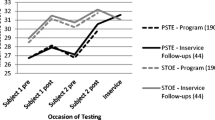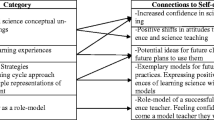Abstract
Given the high attrition rate of beginning science teachers, it is imperative to better prepare science preservice teachers, so that they can be successful during the early years of their teaching. The purpose of this study was to explore science preservice teachers’ views of themselves as a future teacher, in particular their hopes and fears for science teaching and the experiences that help to shape their possible selves. Employed were qualitative methods, which included open-ended surveys and face-to-face interviews. Eleven preservice teachers who enrolled in a secondary science teacher preparation program participated. Findings showed six categories of future selves with the most frequent category being for effective/ineffective science teaching. When their hoped-for and feared selves were not balanced, participants articulated more fears. Regarding the primary influence in shaping their hopes and fears, diverse past experiences related to teaching and learning appeared to be more salient factors than science teacher education program. Given the enriched understanding of the science preservice teachers’ perceptions, we provided suggestions for science teacher educators.
Similar content being viewed by others
References
Alliance for Excellent Education. (2004). Tapping the potential: Retaining and developing high quality new teachers. Washington, DC: Alliance for Excellent Education.
Ambrose, R. (2004). Initiating change in prospective elementary school teachers’ orientations to mathematics teaching by building on beliefs. Journal of Mathematics Teacher Education, 7, 91–119.
Anderson, D., & Piazza, J. (1996). Changing beliefs: Teaching and learning mathematics in constructivist preservice classrooms. Action in Teacher Education, 18, 51–62.
Ashton, P., & Gregoire, M. (2003). At the heart of teaching: The role of emotion in changing teachers’ beliefs. In J. D. Raths & A. R. McAninch (Eds.), Teacher beliefs and classroom performance: The impact of teacher education (pp. 99–121). Greenwich, CT: Information Age Pub.
Borko, H., & Putnam, R. (1996). Learning to teach. In D. Berliner, & R. Calfee (Eds.), Handbook of educational psychology (pp. 673–708). New York: MacMillan.
Bransford, J. D., Darling-Hammond, L., & LePage, P. (2005). Introduction. In L. Darling-Hammond & J. Bransford (Eds.), Preparing teachers for a changing worlds (pp. 1–39). San Francisco, CA: Jossey-Bass.
Bullough, R. V. (1997). Practicing theory and theorizing practice in teacher education. In J. Loughran & T. Russell (Eds.), Purpose, passion, and pedagogy in teacher education (pp. 13–31). London, England/Washington, DC: Falmer Press.
Chapman, D. W. (1984). Teacher retention: The test of a model. American Educational Research Journal, 21, 645–658.
Chapman, D. W. (1994). Reducing teacher absenteeism and attrition: Cause, consequences, and responses. Paris, France: Institute for Education Planning, United Nations Educational, Scientific, and Cultural Organization.
Chapman, D. W., & Green, M. S. (1986). Teacher retention: A further examination. Journal of Educational Research, 79, 273–279.
Chapman, D. W., & Hutcheson, S. M. (1982). Attrition from teaching careers: A discriminate analysis. American Educational Research Journal, 19, 93–105.
Csikszentmihalyi, M. (1990). Flow: The psychology of optimal experience. New York, NY: Harper and Row.
Csikszentmihalyi, M. (1997). Finding flow. New York, NY: Basic Books.
Darling-Hammond, L. (1999). Solving the dilemmas of teacher supply, demand, and standards: How we can ensure a competent, caring, and qualified teacher for every child. New York, NY: National Commission on Teaching and America’s Future.
Darling-Hammond, L. (2000). Teacher quality and student achievement: A review of state policy evidence. Education Policy Analysis Archives, 8, 1–44. Retrieved from http://epaa.asu.edu/epaa/v8n1.
Darling-Hammond, L. (2006). Powerful teacher education: Lesson from exemplary programs. San Francisco, CA: Jossey-Bass.
Darling-Hammond, L., Pacheco, A., Michelli, N., LePage, P., Hammerness, K., & Youngs, P. (2005). Implementing curriculum renewal in teacher education: Managing organizational and policy change. In L. Darling-Hammond & J. Bransford (Eds.), Preparing teachers for a changing world: What teachers should learn and be able to do (pp. 442–479). San Francisco, CA: Jossey-Bass.
Day, J. D., Borkowski, J. G., Punzo, D. L., & Howsepian, B. (1994). Enhancing possible selves in Mexican American students. Motivation and Emotion, 18, 79–103.
Fajet, W., Bello, M., Leftwich, S. A., Mesler, J. L., & Shaker, A. N. (2005). Preservice teachers’ perceptions in beginning education classes. Teaching and Teacher Education, 21, 717–727.
Feiman-Nemser, S. (2001). From preparation to practice: Designing a continuum to strengthen and sustain teaching. The Teachers College Record, 103, 1013–1055.
Fletcher, S. (2007). Mentoring adult learners: Realizing possible selves. In M. Rossiter (Ed.), Possible selves and adult learning: Perspectives and potential (pp. 75–86). San Francisco, CA: Jossey-Bass.
Flores, M. A. (2001). Person and context in becoming a new teacher. Journal of Education for Teaching, 27, 135–148.
Flores, M. A., & Day, C. (2006). Contexts which shape and reshape new teachers’ identities: A multi-perspective study. Teaching and Teacher Education, 22, 219–232.
Gregoire, M. (2003). Is it a challenge or a threat? A dual process model of teachers’ cognition and appraisal processes during conceptual change. Educational Psychology Review, 15, 147–179.
Grossman, P. L. (1990). The making of a teacher: Teacher knowledge and teacher education. New York, NY: Teachers College Press Teachers College Columbia University.
Guarino, C., Santibanez, L., & Daley, A. (2006). Teacher recruitment and retention: A review of the recent empirical literature. Review of Educational Research, 76, 173–208.
Guyton, E., & McIntyre, D. (1990). Student teaching and school experiences. In W. R. Houston, M. Huberman, & J. Sikula (Eds.), Handbook of research in teacher education (pp. 514–534). New York, NY: Macmillan.
Hobson, A. J., & Tomlinson, P. D. (2001, September). Secondary student-teachers’ preconceptions, experiences, and evaluations of ITT. Paper presented at the British Educational Research Association Annual Conference, University of Leeds, Leeds.
Hollingsworth, S. (1989). Prior beliefs and cognitive change in learning to teach. American Educational Research Journal, 26, 160–169.
Holt-Reynolds, D. (1992). Personal history-based beliefs as relevant prior knowledge in course work. American Educational Research Journal, 29, 325–349.
Hoyle, R., & Sherrill, M. (2006). Future orientation in the self-system: Possible selves, self-regulation, and behavior. Journal of Personality, 74, 1673–1696.
Ibarra, H. (1999). Provisional selves: Experimenting with image and identity in professional adaptation. Administrative Science Quarterly, 44, 764–791.
Ingersoll, R. M. (2001). Teacher turnover and teacher shortages: An organizational analysis. American Educational Research Journal, 38, 499–534.
Ingersoll, R. M. (2003). Turnover and shortages among science and mathematics teachers in the United States. In J. Rhoton & P. Bowers (Eds.), Science teachers’ retention: Mentoring and renewal (pp. 1–12). Arlington, VA: National Science Education Leadership Association and National Science Teachers Association Press.
Kersaint, G., Lewis, J., Potter, R., & Meisels, G. (2007). Why teachers leave: Factors that influence retention and resignation. Teaching and Teacher Education, 23, 775–794.
King, L., & Hicks, J. (2007). Lost and found possible selves: Goals, development, and well-being. New Directions for Adult and Continuing Education, 114, 27–37.
Le Compte, M. D., & Preissle, J. (1993). Ethnography and qualitative design in educational research. New York, NY: Academic Press.
Markus, H., & Nurius, P. (1986). Possible selves. American Psychologist, 41, 954–969.
Markus, H., & Wurf, E. (1987). The dynamic self-concept: A social psychological perspective. Annual Review of Psychology, 38, 299–337.
National Commission on Teaching & America’s Future (U.S.). (2002). Unraveling the “teacher shortage” problem: Teacher retention is the key. Washington DC: National Commission on Teaching & America’s Future.
National Commission on Teaching & America’s Future (U.S.). (2003). No dream denied: A pledge to America’s children. New York, NY: National Commission on Teaching & America’s Future.
Olson, L. (2000). Quality counts: Who should teach? Education Week, 19, 8–61.
Oyserman, D., Bybee, D., Terry, K., & Hart-Johnson, T. (2004). Possible selves as roadmaps. Journal of Research in Personality, 38, 130–149.
Oyserman, D., & Fryberg, S. A. (2006). The possible selves of diverse adolescents: Content and function across gender, race, and national origin. In C. Dunkel & J. Kerpelman (Eds.), Possible selves: Theory, research, and applications (pp. 17–39). Huntington, NY: Nova.
Oyserman, D., Gant, L., & Ager, J. (1995). A socially contextualized model of African American identity: Possible selves and school persistence. Journal of Personality and Social Psychology, 69, 1216–1232.
Oyserman, D., & Markus, H. R. (1990). Possible selves and delinquency. Journal of Personality and Social Psychology, 59, 112–125.
Oyserman, D., & Saltz, E. (1993). Competence, delinquency, and attempts to attain possible selves. Journal of Personality and Social Psychology, 65, 360.
Pajares, M. F. (1992). Teachers’ beliefs and educational research: Cleaning up a messy construct. Review of Educational Research, 62, 307–332.
Posner, G., Strike, K., Hewson, P., & Gertzog, W. (1982). Accommodation of a scientific conception: Toward a theory of conceptual change. Science Education, 66, 211–227.
Robinson, B. S., Davis, K. L., & Meara, N. M. (2003). Motivational attributes of occupational possible selves for low-income rural women. Journal of Counseling Psychology, 50, 156–164.
Ryan, K. (1986). The induction of new teachers. Bloomington, IN: Phi Delta Kappan Educational Foundation.
Sadler, T. D. (2006). “I won’t last three weeks”: Preservice science teachers reflect on their student-teaching experiences. Journal of Science Teacher Education, 17, 217–241.
Schulz, R., & Mandzuk, D. (2005). Learning to teach, learning to inquire: A 3-year study of teacher candidates’ experiences. Teaching and Teacher Education, 21, 315–331.
Schutz, P. A., Crowder, K. C., & White, V. E. (2001). The development of a goal to become a teacher. Journal of Educational Psychology, 93, 299–308.
Segall, A. (2002). Disturbing practice: Reading teacher education as text. New York: Peter Lang Publishing.
Serow, R. C., Eaker, D., & Ciechalski, J. (1992). Calling, service, and legitimacy: Professional orientations and career commitment among prospective teachers. Journal of Research & Development in Education, 25, 136–141.
Shen, J. (1997). Teacher retention and attrition in public schools: Evidence from SASS91. Journal of Educational Research, 91, 81–88.
Strauss, A., & Corbin, J. (1998). Basics of qualitative research: Techniques and procedures for developing grounded theory (2nd ed.). Thousand Oaks, CA: Sage.
Theobald, N. D. (1990). An examination of the influence of personal, professional, and school district characteristics on public school teacher retention. Economics of Education Review, 9, 241–250.
Unemori, P., Omoregie, H., & Markus, H. R. (2004). Self-portraits: Possible selves in European-American, Chilean, Japanese, and Japanese American cultural contexts. Self & Identity, 3, 321–338.
Valencia, S., Martin, S., Place, N., & Grossman, P. (2009). Complex interactions in student teaching: Lost opportunities for learning. Journal of Teacher Education, 60, 304–322.
Weiner, B. (1985). An attributional theory of achievement motivation and emotion. Psychological Review, 92, 548–573.
Zeichner, K., & Gore, J. (1990). Teacher socialization. In W. R. Houston, M. Huberman, & J. Sikula (Eds.), Handbook of research in teacher education (pp. 329–348). New York, NY: Macmillan.
Author information
Authors and Affiliations
Corresponding author
About this article
Cite this article
Hong, J., Greene, B. Hopes and Fears for Science Teaching: The Possible Selves of Preservice Teachers in a Science Education Program. J Sci Teacher Educ 22, 491–512 (2011). https://doi.org/10.1007/s10972-011-9247-y
Published:
Issue Date:
DOI: https://doi.org/10.1007/s10972-011-9247-y




